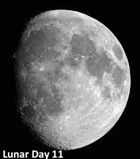The week of January 2 to January 8 takes us from Lunar Day 11 to Day 17. This week we will highlight the Marius dome field located in the NW quadrant of the Field Map and viewable Tuesday evening.
 Marius Hills: [NW/H4; L=53°W] Immediately north and west of the moon crater Marius is the largest dome field on the Moon. Because domes are such low features, you must observe them when the terminator is close, which will be the case on Tuesday evening. The Marius Hills are a combination of low domes, around 1,000 feet high, and steeper volcanoes with genuine cones that go up to 3,000 feet. There are over 300 such formations in this area! In the center of a circular depression, one crater-diameter south of Marius, there is a single unnamed dome with a summit pit. Because it is 6 miles in diameter, it is curious that it remains unnamed. See if you can make it out. (There is a clear drawing of it in Rükl’s Atlas, chart #29.)
Marius Hills: [NW/H4; L=53°W] Immediately north and west of the moon crater Marius is the largest dome field on the Moon. Because domes are such low features, you must observe them when the terminator is close, which will be the case on Tuesday evening. The Marius Hills are a combination of low domes, around 1,000 feet high, and steeper volcanoes with genuine cones that go up to 3,000 feet. There are over 300 such formations in this area! In the center of a circular depression, one crater-diameter south of Marius, there is a single unnamed dome with a summit pit. Because it is 6 miles in diameter, it is curious that it remains unnamed. See if you can make it out. (There is a clear drawing of it in Rükl’s Atlas, chart #29.)
OF ADDITIONAL INTEREST IN SPACE
On Tuesday, Mars will be 0.5° N. of the Moon. The Quadrantid meteor shower will occur on Wednesday.
======================
It is highly recommended that you get a copy of Sky and Telescope’s Field Map of the Moon, the very finest Moon map available for use at the telescope. It is available for $10.95 at www.skyandtelescope.com and on Amazon. All features mentioned in this blog will be keyed to the grid on the Field Map and will look like this: Plato: [NW/D9]
Credits:
Courtesy of Gray Photography of Corpus Christi, Texas
Lunar photos: NASA / USGS / BMDO / LROC / ASU / DLR / LOLA / Moon Globe. Used by permission
- Rupes Cauchy: A Best Known Fault on the Moon - July 22, 2024
- Moon Crater Schickard – Crater Floor has Stripes - July 15, 2024
- Moon Craters Langrenus and Vandelinus - July 8, 2024